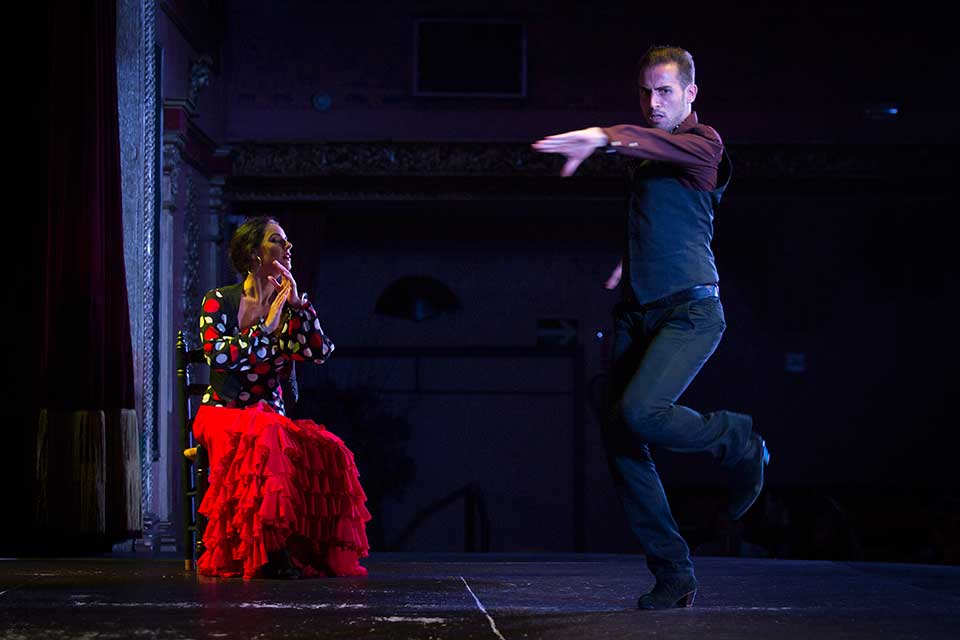- Daily shows: 7 pm, 7:40 pm, 9:30 pm and 10:10 pm

Dinner, flamenco show and party with live music until the body endures. This is the proposal we make from El Palacio Andaluz so that you can spend a New Year’s Eve in Seville, a night full of art and fun. You sign up?
If you wonder what flamenco styles you can enjoy in the show we have prepared for the Special Year Gala, pay attention to what we are going to tell you next.
It is a pure and traditional flamenco performance, which bears the signature of Emilio Ramírez ‘El Duende‘, principal dancer, choreographer and artistic director in this Andalusian tablao. The show is interpreted by a great cast of dancers, guitarists, singers and clappers that give life to a unique function.
The show is designed for the public to enjoy the most outstanding and representative of this art, so it is a tour of different flamenco palos. Do you want to know the most characteristic and striking of each one? Here we go.
The soleá has up to seventeen varieties. Its slow tempo allows to show off to the “bailaora” that can make very feminine movements with the hands, the body and the hips, besides the famous taconeo that the spectator likes so much.
The alegrías de Cádiz is a flamenco palo that belongs to the cantiñas group (cantes of the Cádiz city par excellence). This modality apparently derives from the Navarre-Aragonese jota, hence many of the letters are addressed to the Virgen del Pilar, the Ebro River and Navarra.

For its melody, the joys are festive and encourage the dance. They are similar to the soleá, but with a somewhat faster rhythm. This is where we will hear the famous tiriti tran tran …
Another flamenco stick is taranto, which originates in Almeria. Descends from the taranta, but unlike this one has a compass that allows to dance. It was born at the beginning of the 19th century and is considered the quintessential cante of the Almerian mines. It has been merged with other styles of cante Murcia, Jaen or Malaga. It is considered that Pedro ‘El Morato’ was the first person to sing the taranto and Carmen Amaya, the first to dance it.
On the other hand, the guajiras are native to America and were covered in Andalusian cante. This flamenco stick is an adaptation to melos flamenco of the Cuban point, a series of songs called guajiros that are grown in the rural areas of the island of Cuba. It is for this reason, why the theme we find in the lyrics usually refer to Cuba, especially Havana, its meals, its streets … Among its most prominent interpreters are Enrique Morente or El Niño de la Huerta, among others.
The farruca is one of the most recent flamenco styles. It arises in the folklore of the North of Spain and was introduced in Andalusia by the hand of the waiters who were going to work as seasonal, tavern or fish fryers. Later, they were adapted by Andalusian musicians.

The caña, on the other hand, is perhaps the most important flamenco model. There is a diversity of opinions on the origin of cane. Some say it comes from an ancient Andalusian song and others relate it to the soleá or toná. Curro Dulce, Silverio and Antonio Chacón are the singers who have best captured their essence. However, it would be Chacón who sweetened it and endowed it with its ideal rhythm.
Finally, we talk about the seguiriyas, which together with the soleá and the bulería form the backbone of flamenco. They originated mainly between Seville and Cádiz. In this case, we can name the seguiriyas in various ways due to the enrichment of the Andalusian (sigueriya, siguiriya, or seguidilla).
This stick is the typical cante hondo with tragic lyrics that reflect the suffering of human relationships, love and death. However, despite its painful lyrics, this flamenco stick allows to enjoy a pleasant and cheerful moment. Numerous cantaores delight us with the interpretation of seguiriyas, among which we can highlight Manuel Molina or Antonio Chacón.
These are some of the flamenco styles that are part of the New Year’s Eve show. There are experiences that you should not tell us, that you have to live them! This is the case of the Special Year End Gala that we celebrate at El Palacio Andaluz for next December 31st. We will wait for you!
© 2023 El Palacio Andaluz. All rights reserved.